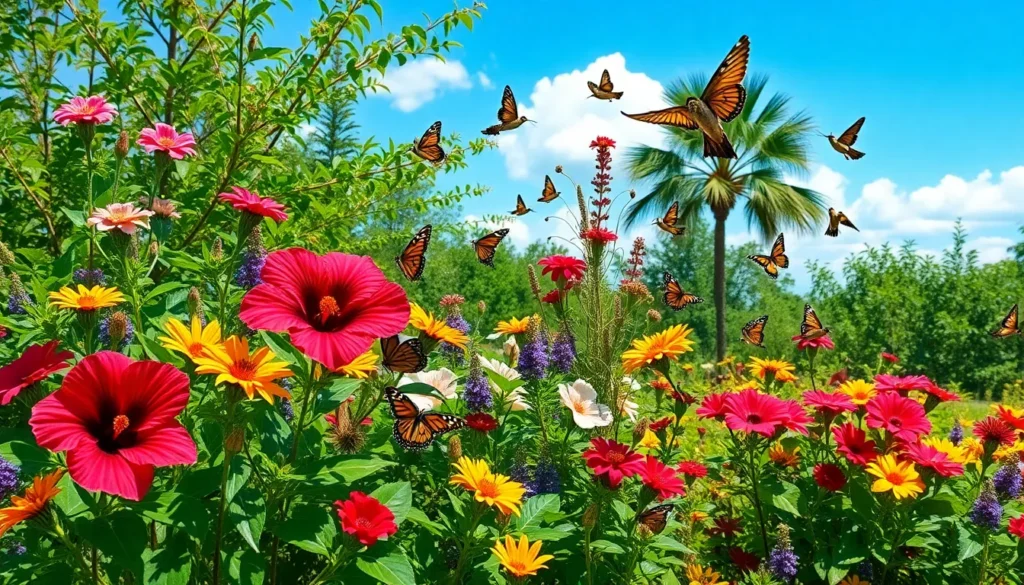Florida’s stunning natural beauty doesn’t have to end at your property line. We’re discovering that native plant landscaping offers homeowners an incredible opportunity to create breathtaking outdoor spaces while supporting local ecosystems. These indigenous plants have evolved over thousands of years to thrive in Florida’s unique climate conditions – from scorching summers to unpredictable rainfall patterns.
Native landscaping isn’t just environmentally responsible; it’s surprisingly practical. We’ve seen homeowners dramatically reduce their water bills maintenance time and fertilizer costs by choosing plants that naturally belong here. Firebush coontie and Simpson’s stopper create vibrant year-round color without the constant care that non-native species demand.
The transformation we witness in native plant gardens is remarkable. Butterflies return hummingbirds visit more frequently and the industry becomes a living sanctuary that changes beautifully with Florida’s seasons. Your yard can become part of Florida’s natural heritage while requiring less work and resources than traditional landscaping approaches.
Understanding Florida’s Native Plant Ecosystems for Landscape Design
Florida’s diverse ecosystems provide us with an incredible foundation for creating landscapes that thrive naturally in our unique climate conditions. We can design more successful native plant gardens by understanding how these natural communities function and selecting plants that work together harmoniously.
Coastal Dune Plant Communities
Coastal dune ecosystems offer us excellent examples of plants that handle extreme conditions with remarkable resilience. Sea oats (Uniola paniculata) anchor sandy soils while creating natural windbreaks for residential properties. Beach sunflower (Helianthus debilis) spreads across open areas with bright yellow blooms that attract pollinators throughout the growing season.
Salt spray tolerance makes these plants perfect for waterfront properties where traditional landscaping often fails. Coontie (Zamia integrifolia) provides structural foundation plantings that require minimal irrigation once established. Railroad vine (Ipomoea pes-caprae) creates natural ground cover that prevents erosion on slopes and embankments.
Sandy soil adaptation allows coastal dune plants to thrive in well-draining conditions common throughout Florida neighborhoods. Firebush (Hamelia patens) produces tubular red flowers that hummingbirds prefer while tolerating poor soil conditions. Blanket flower (Gaillardia pulchella) blooms continuously with minimal care in sunny locations.
Wetland and Marsh Ecosystems
Wetland plant communities teach us how to manage moisture-loving species in low-lying areas of our properties. Blue flag iris (Iris virginica) creates stunning purple displays in rain gardens and bioswales during spring months. Pickerelweed (Pontederia cordata) attracts butterflies with spike-shaped flower clusters while helping filter stormwater runoff.
Moisture management becomes easier when we incorporate plants adapted to Florida’s wet and dry seasonal patterns. Swamp milkweed (Asclepias incarnata) supports monarch butterfly populations while handling both flooding and drought conditions. Cardinal flower (Lobelia cardinalis) provides brilliant red color in shaded wet areas where few other plants bloom successfully.
Natural filtration occurs when wetland plants remove excess nutrients from water flowing through our landscapes. Arrowhead (Sagittaria latifolia) produces distinctive white flowers above arrow-shaped leaves in shallow water features. Duck potato (Sagittaria lancifolia) grows in boggy areas while providing food sources for waterfowl that visit our properties.
Pine Flatwoods and Scrub Habitats
Pine flatwoods ecosystems demonstrate how plants adapt to periodic fire cycles and sandy soils with acidic conditions. Longleaf pine (Pinus palustris) creates natural canopy structure for larger properties while supporting diverse understory communities. Wiregrass (Aristida stricta) forms the foundation layer that many other native species depend upon for establishment.
Fire adaptation shows us which plants handle Florida’s natural burn cycles and can recover quickly from maintenance pruning. Saw palmetto (Serenoa repens) provides year-round structure while requiring minimal care in sunny locations. Gallberry (Ilex glabra) offers small white flowers followed by dark berries that birds consume throughout winter months.
Scrub habitat plants excel in extremely well-drained soils where water stress occurs regularly during dry periods. Florida rosemary (Ceratiola ericoides) creates aromatic evergreen hedges that deer avoid browsing. Sand live oak (Quercus geminata) develops into sculptural specimens that provide shade and wildlife habitat in coastal areas.
Top Native Trees for Creating Stunning Florida Landscapes
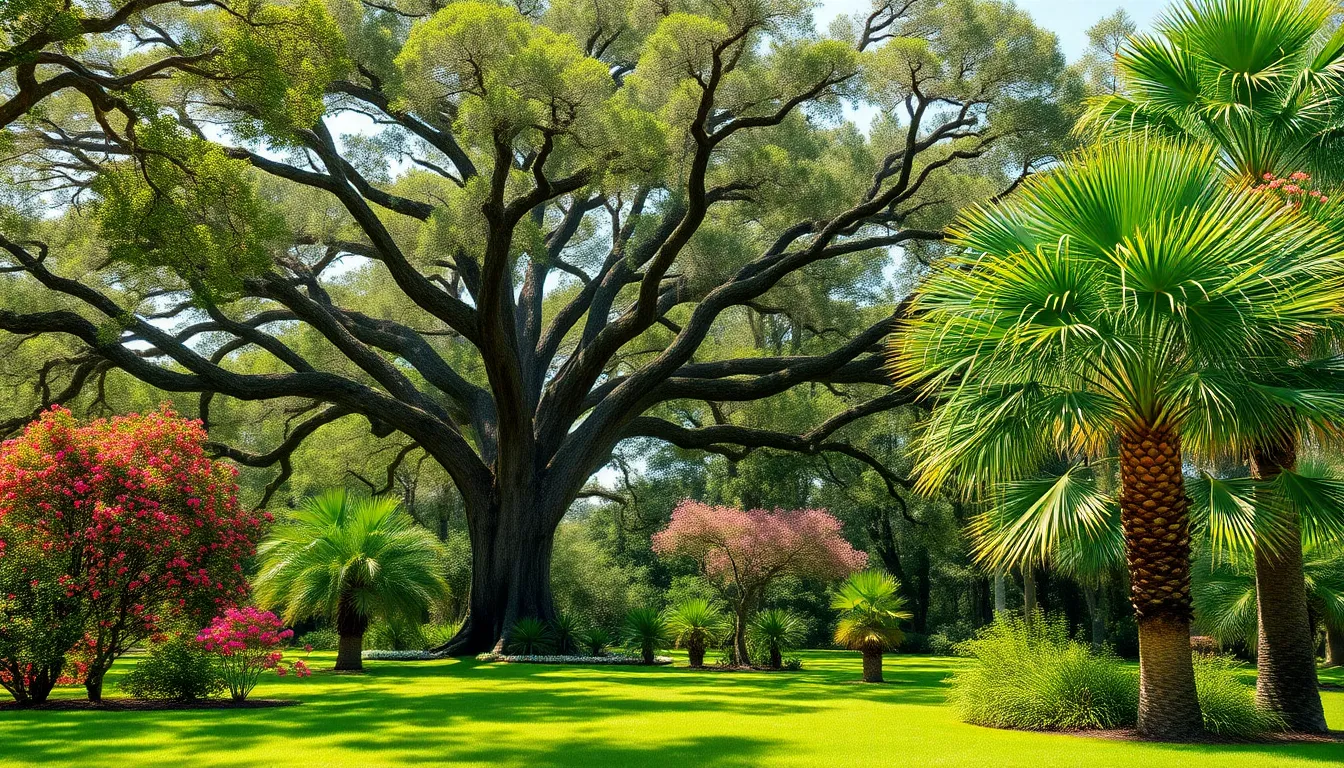
We’ve explored Florida’s diverse ecosystems and their plant communities, so now let’s focus on the trees that can transform your industry into a stunning showcase of native beauty.
Majestic Live Oaks and Their Industry Impact
Live Oaks (Quercus virginiana) stand as Florida’s most iconic and majestic native trees. These large, spreading evergreen oaks create broad canopies that provide essential shade and establish a stately presence in any industry. We love how they contribute significantly to industry aesthetics while simultaneously supporting native wildlife throughout the year.
Establishment of Live Oaks creates natural gathering spaces beneath their expansive branches. The trees develop distinctive horizontal branching patterns that can span impressive distances, making them perfect focal points for large properties. Their evergreen nature ensures year-round beauty, while their deep root systems help prevent soil erosion in Florida’s sandy conditions.
Wildlife benefits from Live Oaks extend far beyond their visual appeal. These trees support many bird species, provide acorns for wildlife, and create microhabitats that benefit the entire network. We’ve observed that properties with mature Live Oaks often become wildlife corridors that connect fragmented habitats.
Colorful Flowering Trees Like Redbud and Dogwood
Flowering trees like Redbud and Dogwood add charming seasonal color in spring with their blossoms. These native species enhance industry diversity and beauty through their spectacular displays of pink, white, and purple flowers that emerge before the leaves unfold. We appreciate how they create stunning visual interest during Florida’s mild spring season.
Redbud trees produce heart-shaped leaves and vibrant pink flowers that cover bare branches. Their compact size makes them perfect for smaller landscapes or as understory trees beneath larger canopies. The flowers attract early pollinators when few other blooms are available, making them valuable for supporting local bee populations.
Dogwood species offer delicate white or pink bracts that resemble large flowers. These trees prefer partial shade conditions and complement larger native trees beautifully. We’ve found they work exceptionally well in woodland gardens and naturalized areas where they can display their elegant branching patterns.
Palm Species Native to Florida
Native palm species provide tropical texture and height to Florida landscapes with remarkable adaptability. Florida boasts several indigenous palm varieties that thrive in local conditions while adding distinctive architectural elements to garden designs. We recommend these species for their proven performance and ecological benefits.
| Palm Species | Key Features | Industry Use |
|---|---|---|
| Buccaneer Palm | Compact size, hurricane resistant | Small gardens, coastal areas |
| Florida Thatch Palm | Silvery fronds, drought tolerant | Accent planting, groupings |
| Paurotis Palm | Clustering habit, wetland adapted | Rain gardens, pond edges |
| Royal Palm | Tall stature, smooth trunk | Formal landscapes, avenues |
| Silver Saw Palmetto | Low growing, extremely hardy | Ground cover, natural areas |
Adaptation to Florida’s environment makes these palms superior choices over exotic species. They’re well suited to handle hurricanes, salt spray, and periods of drought that challenge non-native palms. We’ve observed that native palms require minimal irrigation once established and rarely need fertilization in appropriate soil conditions.
Support for local fauna comes naturally with native palm plantings. These species provide nesting sites for birds, food sources through their fruits, and habitat for various insects that support the food web. Their deep root systems also help stabilize soil in coastal and wetland environments where erosion can be problematic.
Essential Native Shrubs That Transform Florida Gardens
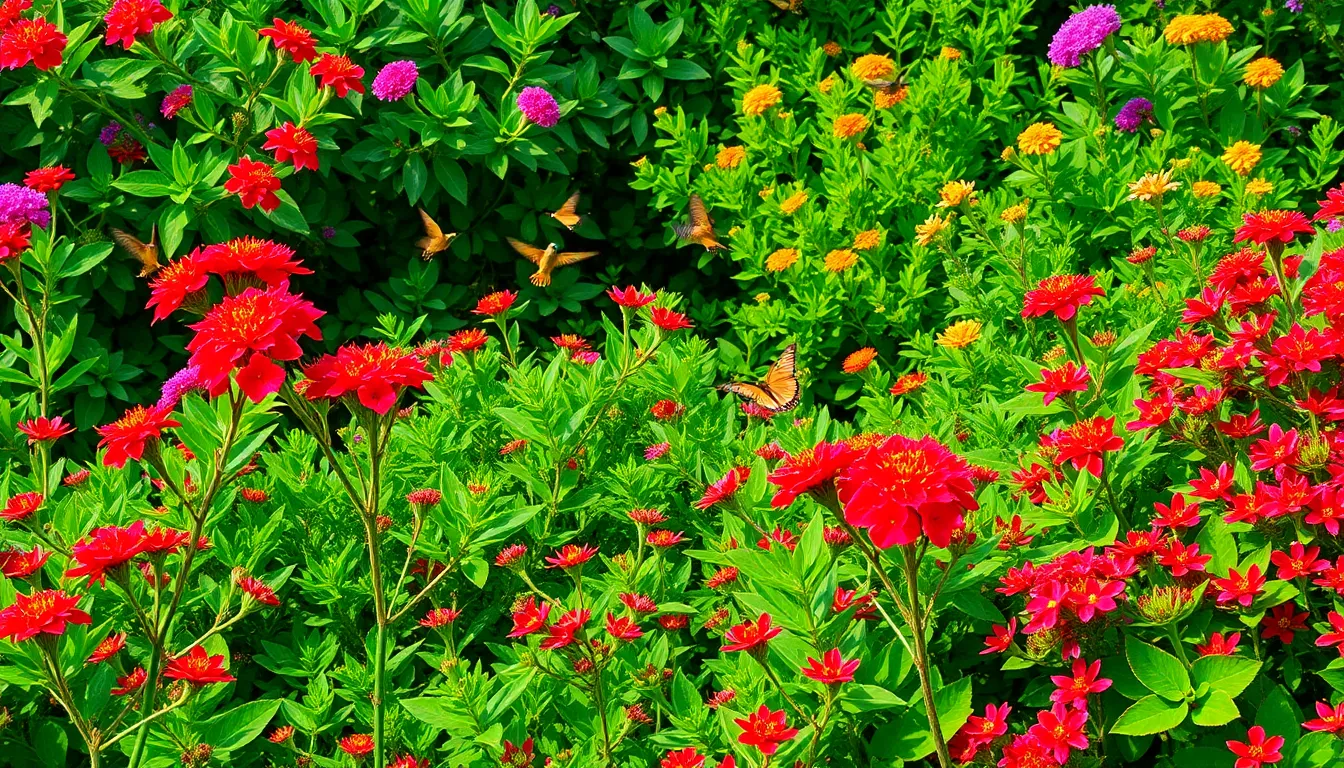
Native shrubs form the backbone of successful Florida landscapes, providing year-round structure while supporting local wildlife. We’ve identified the most impactful species that’ll create stunning visual displays while requiring minimal maintenance.
Firebush and Other Butterfly-Attracting Shrubs
Firebush (Hamelia patens) stands out as our top recommendation for attracting pollinators with its bright red-orange tubular flowers. This remarkable shrub blooms continuously throughout the growing season, drawing hummingbirds, butterflies, and other beneficial insects to your garden.
Hibiscus coccineus delivers dramatic impact with its large crimson blooms that attract many pollinators. Each flower lasts only one day, but the plant produces blooms profusely during its season, creating constant visual interest.
Lantana involucrata naturally occurs along Florida’s coastal dunes and hammocks, making it perfectly adapted to our climate conditions. Butterflies and other pollinators flock to its small clustered flowers, while its drought tolerance makes maintenance effortless.
Beautyberry (Callicarpa americana) produces vibrant purple berries that birds absolutely love, especially during fall migration periods. The berries create stunning autumn displays while providing essential food sources for native wildlife.
Erythrina herbacea features striking red tubular flowers that specifically appeal to hummingbirds and butterflies. This woody shrub adds vertical interest to garden designs while supporting our local pollinator populations.
Native Azaleas for Seasonal Color
Florida’s native azaleas provide spectacular seasonal displays that rival any imported ornamental. These deciduous types thrive best in partly shaded environments, making them perfect for understory plantings beneath our native trees.
Spring brings vibrant floral displays when native azaleas burst into bloom, creating natural focal points throughout the industry. Their flowers blend beautifully with other native species, maintaining the authentic Florida aesthetic we’re cultivating.
Partly shaded locations offer ideal growing conditions for these native beauties, allowing them to establish strong root systems while avoiding harsh afternoon sun. We recommend planting them near existing native trees for natural protection and visual harmony.
Salt-Tolerant Coastal Shrubs
Lantana involucrata excels in coastal conditions, naturally tolerating high salt levels and sandy soils that challenge many other plants. This coastal native stabilizes dunes while providing essential habitat for local wildlife.
Coontie (Zamia pumila) serves as an excellent low-growing option with tough foliage that withstands salt spray and wind exposure. This ancient cycad adds unique texture to coastal landscapes while requiring virtually no maintenance once established.
Coastal variants of beautyberry and other native shrubs have adapted specifically to salt spray and constant wind conditions. These specialized selections help prevent erosion while maintaining the natural beauty of Florida’s shoreline communities.
Forestiera segregata blooms in early spring, providing crucial nectar sources for bees and butterflies when few other plants are flowering. Its salt tolerance makes it valuable for coastal restoration projects and beachfront landscaping.
Salt-tolerant natives create living barriers that protect inland plants from harsh coastal conditions while supporting local ecosystems. We use these hardy shrubs to establish the foundation of successful coastal gardens that thrive year after year.
Beautiful Native Groundcovers and Perennials for Florida Landscapes
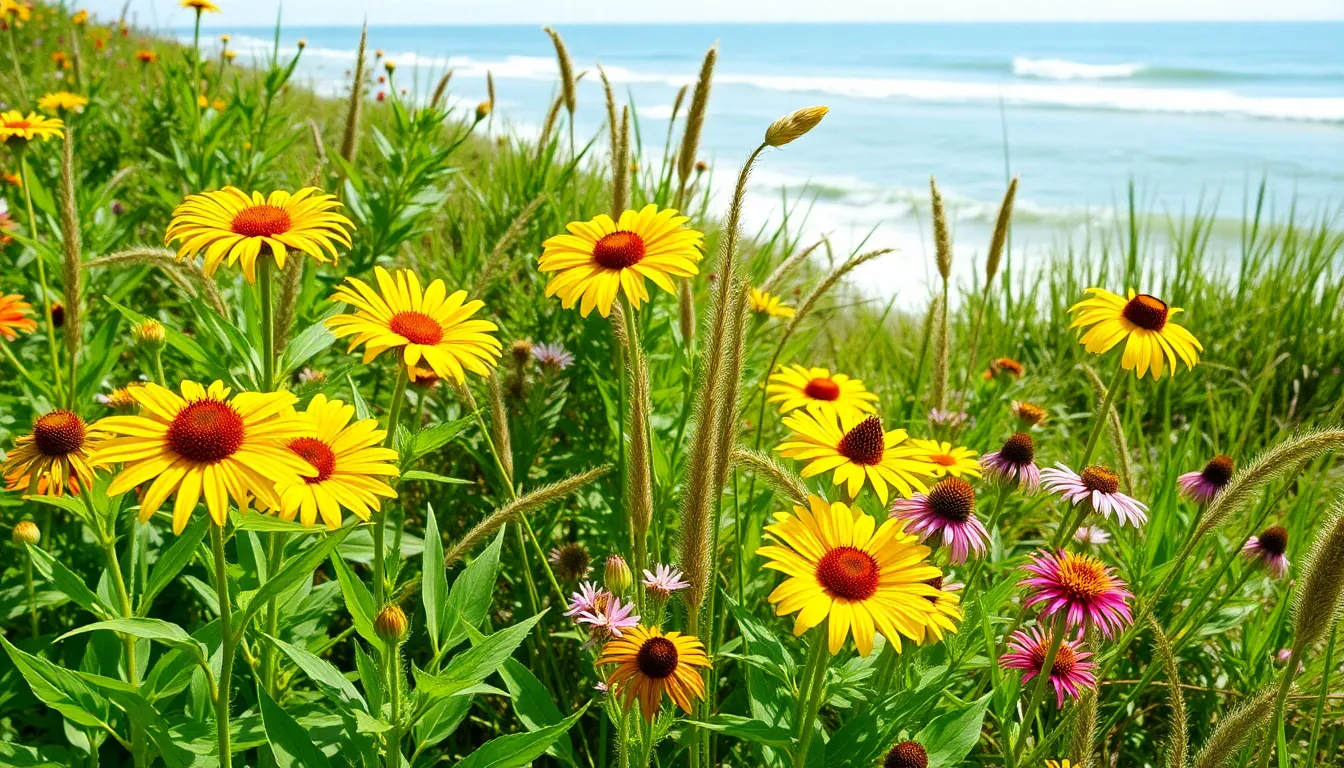
We’ll explore the essential groundcovers and perennials that complete your native Florida industry, offering low maintenance answers that thrive in our diverse climate conditions.
Beach Sunflower and Dune Stabilizing Plants
Beach Sunflower (Helianthus debilis) stands out as a robust groundcover with bright yellow flowers that’s perfectly adapted to sandy soils and sunny coastal locations. This hardy perennial spreads naturally across dunes while providing continuous blooms that attract native pollinators throughout the growing season.
Sea oats (Uniola paniculata) serve as crucial partners in coastal landscaping, specifically designed by nature to stabilize dunes and prevent devastating erosion. Their deep root systems anchor sandy soils while their graceful seed heads add texture and movement to beachfront gardens.
Railroad vine (Ipomoea pes-caprae) completes the coastal trio with its rapid spreading habit and exceptional salt tolerance, making it incredibly effective at holding sand in place. We recommend this vine for homeowners dealing with shifting soils or those wanting to create natural barriers against coastal winds.
Wildflower Mixes for Natural Meadow Areas
Coreopsis species, Florida’s official state wildflower, creates stunning displays with bright yellow to pink blooms that require minimal care once established. These cheerful perennials self seed readily and provide months of continuous color in naturalized areas.
Milkweed (Asclepias species) serves dual purposes by supporting monarch butterflies while adding unique flower clusters in shades of orange, pink, and white. Planting various milkweed species ensures continuous blooms and critical habitat for migrating monarchs.
Coneflower (Rudbeckia fulgida) attracts countless pollinators with its daisy like blooms and thrives in open, sunny meadow conditions. Birds appreciate the seed heads in fall and winter, extending the plant’s value beyond its blooming period.
Blanketflower (Gaillardia pulchella) rounds out meadow plantings with drought tolerant characteristics and vibrant red and yellow petals. This native annual reseeds itself and creates natural drifts of color that change with each growing season.
Shade Loving Native Perennials
Spiderwort (Tradescantia ohiensis) produces delicate purple to blue flowers that open in morning light and thrives in moist, shaded woodland conditions. Each bloom lasts only one day, but new flowers appear continuously throughout the growing season.
Illicium parviflorum functions as an evergreen shrub or small tree that’s perfectly suited for shaded, mesic hammock environments. This aromatic plant provides year round structure while requiring virtually no maintenance once established.
Wild violet (Viola species) offers delicate flowers and reliable groundcover in low light conditions where other plants struggle. These charming perennials spread naturally through underground runners and provide early nectar sources for native bees and butterflies.
Water-Wise Native Plants for Sustainable Florida Landscaping
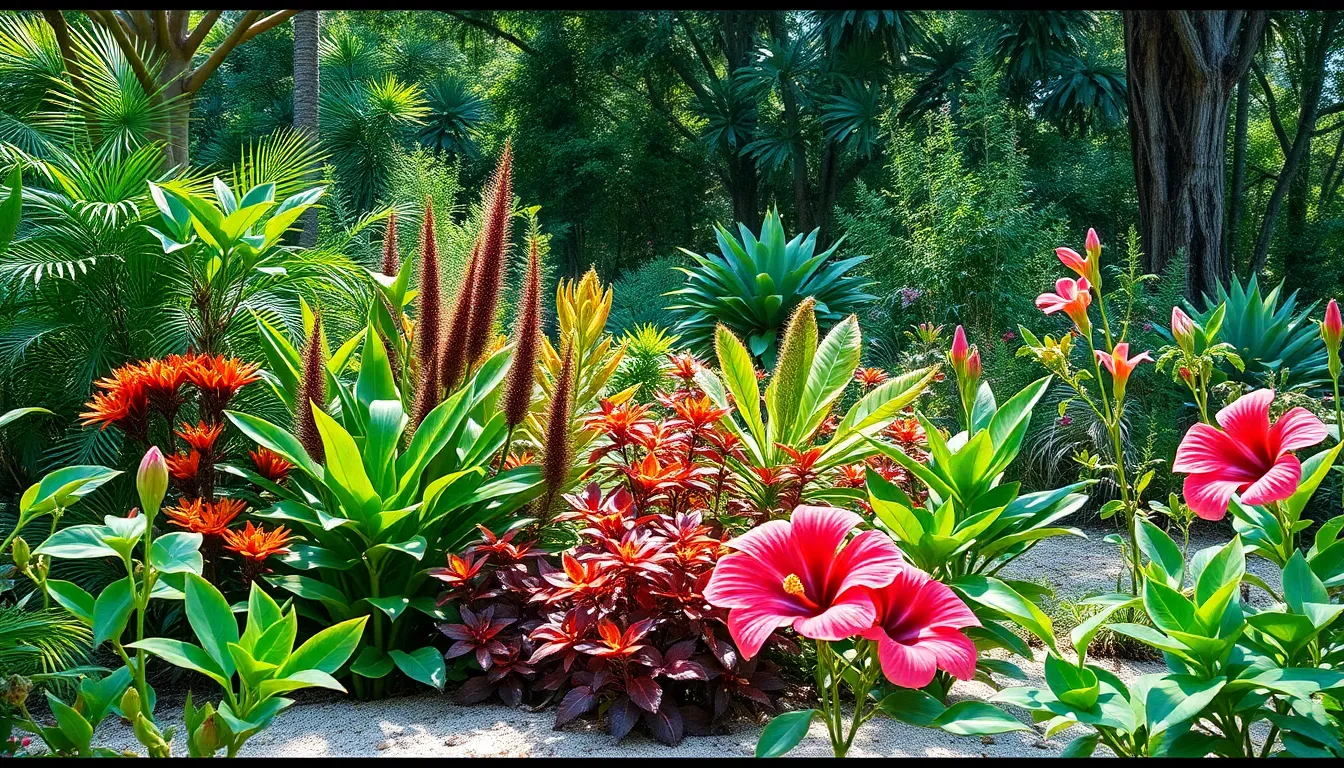
Building on the foundation of native trees, shrubs, and groundcovers, we’ll explore specialized plant selections that maximize water conservation while maintaining stunning landscapes. These water-wise natives are perfectly adapted to Florida’s climate conditions and significantly reduce irrigation needs.
Drought-Tolerant Scrub Plants
Garberia heterophylla stands out as a state-listed threatened species that deserves our attention in sustainable landscaping. This remarkable scrub plant serves as a vital nectar source for butterflies and bees while thriving in Florida’s challenging dry conditions. We’ve found that it flourishes in sandy soils with minimal nutrients, making it perfect for homeowners seeking low-maintenance options.
Geobalanus oblongifolius offers year-round blooming potential in our scrub industry designs. This hardy, low-growing shrub adapts exceptionally well to both pine flatwoods and scrub areas, providing continuous visual interest without demanding frequent watering. Gardens featuring this resilient native create beautiful displays while supporting local wildlife throughout the seasons.
Sandy soil conditions actually benefit these scrub specialists, as they’ve evolved to extract maximum nutrition from nutrient-poor environments. We recommend grouping these plants together to create drought-resistant garden zones that require minimal supplemental irrigation.
Rain Garden Native Species
Illicium parviflorum transforms wet industry areas into functional beauty while managing stormwater runoff effectively. This evergreen shrub naturally occurs in seepage swamps and mesic hammocks, making it ideally suited for rain garden applications. We’ve observed how it filters water efficiently while providing habitat for local wildlife.
Hibiscus coccineus brings dramatic color to our rain garden designs with its large crimson flowers that attract essential pollinators. These stunning blooms create focal points in wetter industry areas while serving the practical purpose of stormwater management. Native plants like this demonstrate how functional landscaping can also be visually spectacular.
Stormwater capture becomes an asset rather than a problem when we incorporate these moisture-loving natives into our designs. Rain gardens featuring these species protect local lakes, streams, and springs by filtering runoff before it reaches natural water bodies.
Native Grasses for Low-Maintenance Areas
Muhly grass provides exceptional drought tolerance while creating attractive ground cover that requires minimal ongoing care. We’ve seen how this native grass stabilizes soil and prevents erosion, making it invaluable for sustainable industry design. Its adaptability to various growing conditions makes it suitable for diverse Florida landscapes.
Soil stabilization occurs naturally when we establish native grass areas, reducing the need for costly erosion control measures. These grasses support native insects and birds, creating mini ecosystems within our designed landscapes. Wildlife benefits multiply when we choose native grasses over traditional turf alternatives.
Water conservation reaches optimal levels with native grass selections that thrive on natural rainfall patterns. Many nurseries now offer improved selections of these native species, making it easier for homeowners to succeed with water-wise landscaping choices.
Native Plants That Support Florida Wildlife
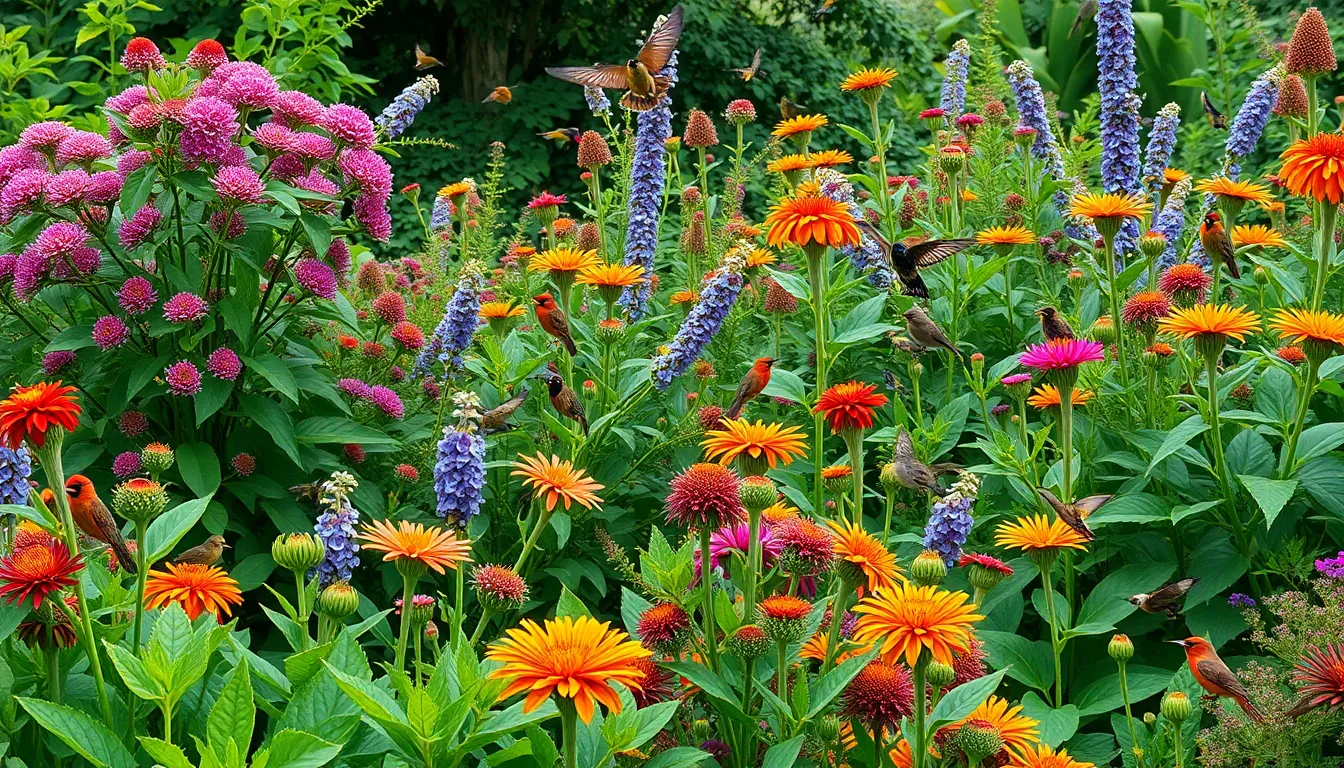
Florida’s nearly 3,000 native plant species create essential ecological partnerships that have evolved over thousands of years with local wildlife. We’re building sustainable landscapes that provide critical food sources, shelter, and breeding grounds for birds, butterflies, and countless other creatures when we choose native plants.
Bird-Friendly Berry-Producing Plants
Berry producing plants serve as natural bird feeders throughout Florida’s diverse seasons. We recommend beautyberry (Callicarpa americana) for its stunning purple clusters that attract mockingbirds, cardinals, and blue jays during fall migration periods. Coralberry (Symphoricarpos orbiculatus) extends the feeding season with its persistent white berries that sustain birds through winter months.
Elderberry (Sambucus canadensis) produces dark purple berries that over 40 bird species consume, making it one of our most valuable wildlife plants. We’ve observed that firebush (Hamelia patens) not only attracts hummingbirds with its tubular flowers but also provides small red berries for smaller songbirds like painted buntings and indigo buntings.
Wild coffee (Psychotria nervosa) offers bright red berries in shaded areas where many birds seek shelter during hot summer days. These native berry producers create year round food webs that support stable bird populations while reducing our reliance on artificial bird feeders.
Native Host Plants for Butterflies
Host plants provide essential nurseries where butterflies lay eggs and caterpillars develop into adults. We plant milkweed species (Asclepias spp.) to support monarch butterfly populations during their incredible migration journeys. Native milkweeds like swamp milkweed (Asclepias incarnata) and tropical milkweed (Asclepias curassavica) serve as both host plants for monarch caterpillars and nectar sources for adult butterflies.
Passionflower vines (Passiflora spp.) host gulf fritillary and zebra longwing butterflies, Florida’s state butterfly. Wild lime (Zanthoxylum fagara) supports giant swallowtail butterflies, while spicebush (Lindera benzoin) hosts spicebush swallowtails in northern Florida regions.
Partridge pea (Chamaecrista fasciculata) feeds little yellow and sleepy orange butterfly caterpillars while producing bright yellow flowers. We’ve found that cassia species like wild senna (Senna hebecarpa) support cloudless sulphur and orange barred sulphur butterflies, creating vibrant yellow blooms that attract adult butterflies for nectar.
Pollinator Gardens with Native Flowers
Native flowering plants create pollinator magnets that support bees, butterflies, and hummingbirds throughout Florida’s extended growing seasons. We design pollinator gardens using purple coneflowers (Echinacea purpurea) and black eyed Susans (Rudbeckia hirta) as anchor plants that bloom for months while requiring minimal maintenance.
Coral honeysuckle (Lonicera sempervirens) attracts ruby throated hummingbirds with its tubular red flowers, while native bees prefer the open faces of blanket flowers (Gaillardia pulchella). Wild bergamot (Monarda fistulosa) draws both butterflies and native bees with its fragrant purple blooms that also serve as natural pest deterrents.
Stokes’ aster (Stokesia laevis) provides late season nectar when many other plants have finished blooming. We include blazing star (Liatris spicata) for its tall purple spikes that monarch butterflies particularly favor during fall migrations. These native flower combinations support over 300 bee species native to Florida while creating stunning visual displays that change throughout the seasons.
Regional Considerations for Florida Native Plant Landscapes
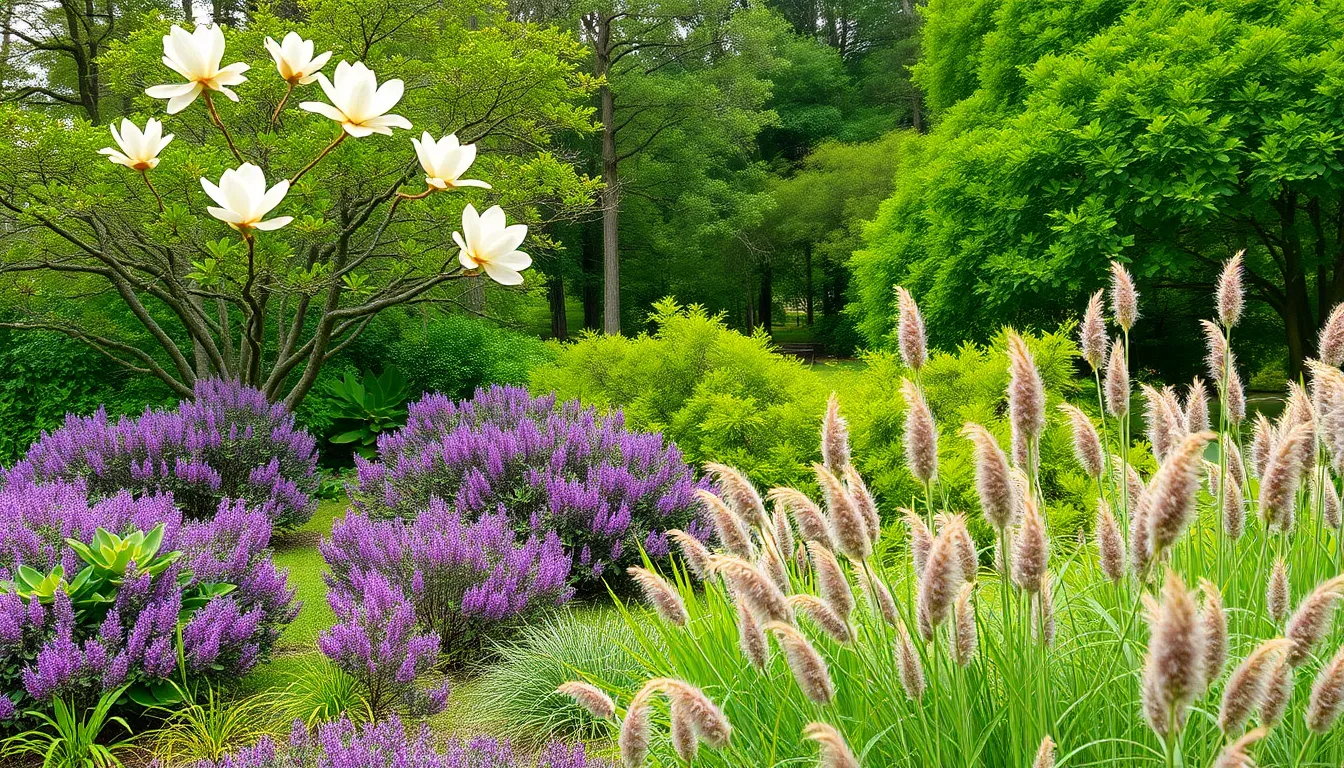
Florida’s diverse climate zones require different native plant selections to ensure successful landscaping outcomes. We’ll explore the exact species that thrive in each region’s unique conditions.
North Florida Temperate Species
North Florida experiences cooler winters and periodic freezes that demand cold-hardy native selections. Our region’s temperate climate supports magnificent trees like Southern magnolia (Magnolia grandiflora), which creates stunning focal points with its large white blooms and glossy evergreen leaves. These majestic specimens adapt perfectly to well-drained soils and provide year-round structure.
Beautiful shrubs flourish in North Florida’s moderate temperatures and seasonal variations. Beautyberry (Callicarpa americana) produces clusters of bright purple berries that feed over 40 bird species during fall migration. This deciduous shrub requires minimal care while offering exceptional wildlife value.
Ornamental grasses add texture and movement to North Florida landscapes. Muhly grass (Muhlenbergia capillaris) creates spectacular fall displays with its pink-purple plumes that catch morning light. These drought-tolerant clumps establish quickly in sandy soils and provide nesting material for songbirds.
Central Florida Transition Zone Plants
Central Florida’s mild winters and hot summers create ideal conditions for unique transition zone species. Coontie (Zamia pumila) serves as Florida’s only native cycad, producing distinctive cone-like structures while tolerating both occasional cold snaps and prolonged heat. This prehistoric plant adds architectural interest to shaded areas.
Rare native shrubs thrive in Central Florida’s balanced climate conditions. Illicium parviflorum, an evergreen shrub native to seven Central Florida counties, produces small yellow flowers and thrives in moist, partially shaded locations. We recommend this species for gardeners seeking uncommon natives with proven regional adaptation.
Specialized flowering shrubs provide critical wildlife resources in the transition zone. Garberia heterophylla, a rare nectar-rich shrub native to north and central Florida, supports many butterfly species including the endangered Bartram’s scrub-hairstreak. This plant requires well-drained sandy soils and full sun exposure.
South Florida Tropical Natives
South Florida’s subtropical to tropical climate supports year-round growing seasons for warm-weather natives. Lantana involucrata thrives in coastal and dune hammocks from Central Florida southward, producing small orange-red flowers that attract butterflies and hummingbirds. This salt-tolerant shrub requires minimal water once established.
Moisture-loving natives create stunning displays in South Florida’s humid environment. Hibiscus coccineus produces large red flowers up to 6 inches across and thrives in moist soils near water features. These tall perennials can reach 8 feet in height and provide dramatic vertical accents.
Specialized woody perennials adapt to South Florida’s unique growing conditions. Geobalanus oblongifolius, native to scrubby flatwoods and sandhills in the southern peninsula, produces small white flowers throughout the year. This low-growing shrub tolerates poor soils and provides ground cover in challenging sites.
Design Principles for Successful Native Plant Landscapes
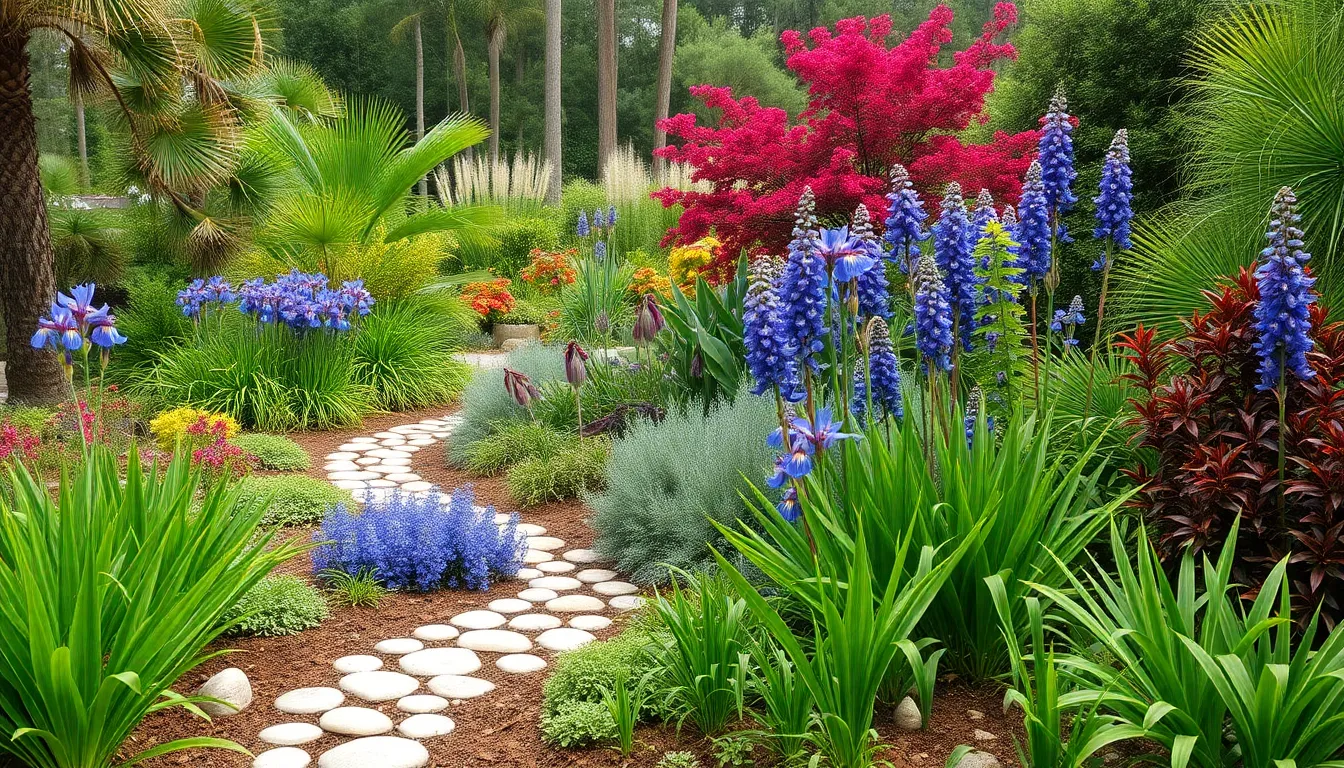
Successful native plant landscapes in Florida require thoughtful planning that mimics natural ecosystems while creating beautiful, functional outdoor spaces. We’ll explore key design principles that ensure your native garden thrives with minimal maintenance while supporting local wildlife.
Creating Natural Plant Communities
Creating authentic plant communities starts with understanding your property’s original network. We recommend researching historical vegetation maps and identifying relic native trees to determine which plant communities naturally occurred on your site, such as pine flatwoods, scrub habitats, or wetland areas.
Mimicking these natural communities involves selecting plants that would naturally grow together in Florida’s wild landscapes. Grouping species by their soil, drainage, and sunlight requirements creates more resilient plantings that support each other’s growth. For example, we might combine Longleaf pine with Wiregrass and Wild lupine to recreate a pine flatwood community, or pair Blue flag iris with Swamp milkweed in moisture retaining areas.
Biodiversity flourishes when we layer plants at different heights, just like natural ecosystems. Canopy trees like Live oak provide structure, understory shrubs like Firebush offer mid level interest, and groundcovers like Beach sunflower complete the natural hierarchy. This layered approach creates habitat niches for various wildlife species while establishing a visually compelling industry.
Seasonal Interest and Succession Planting
Succession planting ensures continuous visual appeal throughout Florida’s growing seasons by selecting species with staggered flowering and fruiting periods. We achieve year round interest by combining early spring bloomers like Native azaleas with summer performers like Hibiscus coccineus and fall fruiting plants like Beautyberry.
Timing becomes crucial when planning seasonal displays that support wildlife needs. Spring flowering natives like Redbud provide early nectar sources when few other plants are blooming, while late season bloomers like Garberia heterophylla offer critical resources during migration periods. Creating these successive waves of bloom ensures pollinators have consistent food sources.
Foliage variation adds another layer of seasonal interest beyond just flowers and fruits. We incorporate plants with different leaf textures, colors, and seasonal changes to maintain visual appeal even during dormant periods. Native grasses like Muhly grass provide stunning fall color, while evergreen species like Coontie maintain structure during winter months.
Incorporating Hardscape with Native Plantings
Hardscape elements enhance native gardens by providing functional pathways and seating areas while complementing natural plant textures. We select materials that echo Florida’s natural landscapes, such as shell pathways in coastal areas or limestone features in central regions, creating seamless transitions between built and natural elements.
Texture contrast between hardscape and plantings creates visual interest and defines garden spaces effectively. Smooth river rocks paired with the fine texture of native grasses, or rough cypress mulch surrounding broad leafed plants like Wild ginger, establish ever-changing relationships that guide the eye through the industry.
Mulch beds serve as both hardscape elements and functional plant supporters in native gardens. We use locally sourced materials like pine needles in acidic plant communities or shell mulch in coastal plantings to maintain soil conditions while reducing maintenance needs. These natural mulches also provide habitat for beneficial insects and slowly decompose to enrich the soil.
Water features integrated with native plantings create focal points while supporting local wildlife. Rain gardens designed with native sedges and rushes manage stormwater runoff naturally, while small ponds surrounded by native ferns and wildflowers attract birds and butterflies. These features demonstrate how hardscape can enhance rather than compete with native plant communities.
Maintenance and Care of Florida Native Plant Landscapes
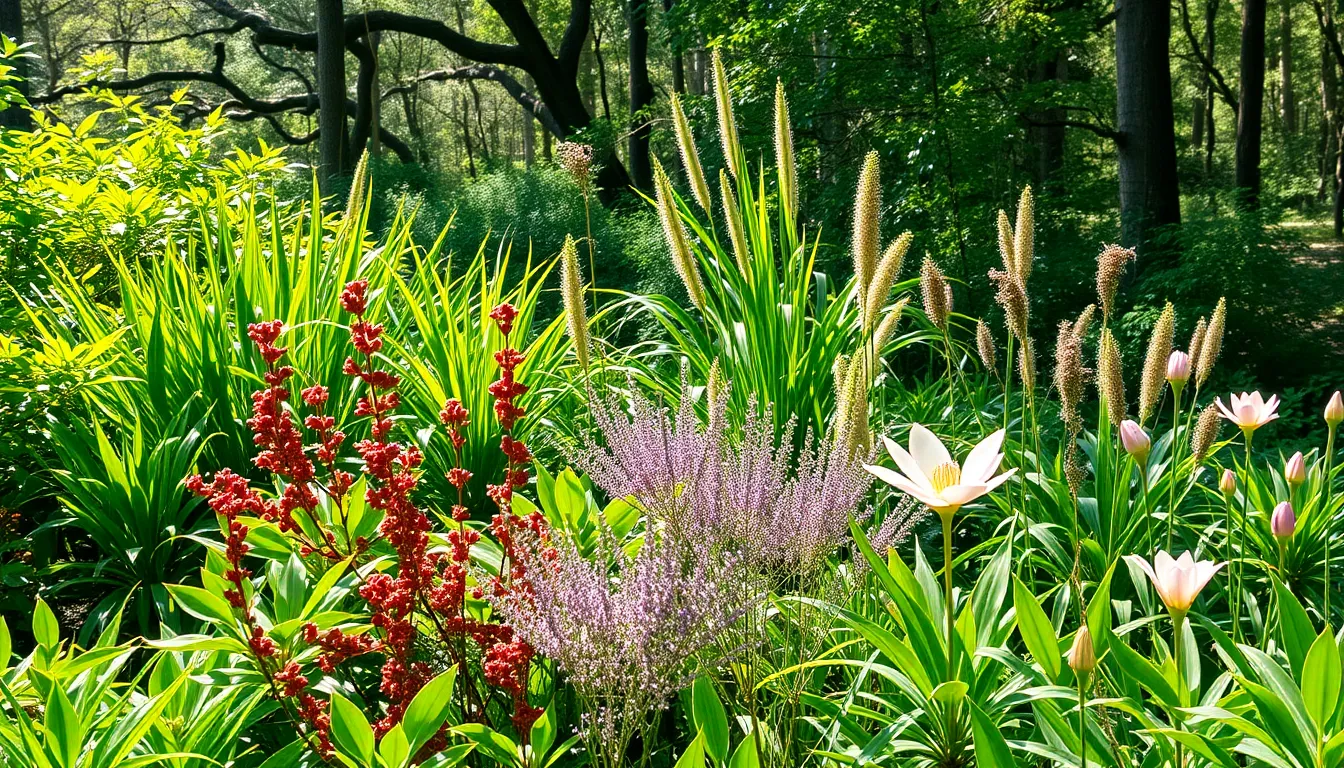
Successful native plant landscapes require strategic care during establishment and thoughtful long-term maintenance practices. We’ll guide you through the essential steps to ensure your Florida native garden thrives for years to come.
Establishment Period Care
First 1 to 3 years demand our most attentive care as native plants adapt to their new environment and develop strong root systems. Regular weeding becomes critical during this phase since invasive exotic species can quickly overtake native plantings in Florida’s climate.
Mulching provides essential benefits by retaining soil moisture, regulating temperature, and suppressing weed growth throughout the establishment period. We recommend reapplying mulch as needed, particularly during the first three years when plants are most vulnerable.
Supplemental watering supports root development even though native plants are naturally adapted to Florida’s climate patterns. Young plants need consistent moisture during dry spells to establish deep root systems that will sustain them long term.
Proper site selection minimizes maintenance requirements by matching plants to their preferred habitats based on sunlight exposure, soil moisture levels, and nutrient conditions. This strategic placement reduces plant stress and creates optimal growing conditions from the start.
Long-Term Maintenance Requirements
Minimal fertilization keeps established natives healthy since most species thrive without additional nutrients when planted in suitable locations. Over fertilizing can actually harm native plants and negatively impact the surrounding environment.
Occasional pruning maintains plant health while preserving natural growth forms that native species develop over time. We focus on removing dead or diseased branches and light shaping for aesthetic purposes rather than heavy pruning.
Ongoing weed monitoring protects biodiversity by preventing invasive species from establishing and competing with our native plantings. Consistent removal of unwanted plants maintains the ecological balance we’ve created.
Mature plants rarely need irrigation except during prolonged drought periods since they’ve adapted to local rainfall patterns over thousands of years. This natural adaptation significantly reduces our water usage compared to traditional landscaping.
| Maintenance Task | Establishment Period (Years 1-3) | Long-term (Year 4+) |
|---|---|---|
| Watering frequency | Weekly during dry spells | Drought periods only |
| Weeding schedule | Monthly monitoring | Seasonal checks |
| Mulch replacement | Annually | Every 2-3 years |
| Fertilization needs | None to minimal | None required |
Natural Pest and Disease Management
Native plants support beneficial insect populations including bees, butterflies, and predatory insects that naturally manage pest problems without chemical interventions. This biodiversity creates a self regulating network within our landscapes.
Reduced chemical dependency protects the environment since native species’ natural adaptability means they typically require fewer pesticides and fungicides than non native alternatives. Their built in resistance mechanisms handle most common threats effectively.
Regular observation enables early intervention when pest or disease issues do arise, allowing us to address problems with non chemical methods like manual removal or introducing natural predators. Early detection prevents minor issues from becoming major problems.
Natural resistance mechanisms protect plant communities as native species have evolved alongside local pests and diseases over millennia. Popular species like beautyberry, muhly grass, coontie, and Southern magnolia demonstrate this inherent resilience in Florida landscapes.
Conclusion
We’ve explored how Florida native plant landscapes offer the perfect solution for creating stunning outdoor spaces that work harmoniously with our state’s natural environment. These gardens aren’t just beautiful—they’re smart investments that reduce maintenance costs while supporting the incredible biodiversity that makes Florida unique.
By choosing native plants we’re making a difference for local wildlife from butterflies to birds while enjoying landscapes that thrive naturally in our climate. Whether you’re designing a coastal garden with sea oats or creating a pollinator haven with native wildflowers each plant selection contributes to a healthier network.
The journey to native landscaping doesn’t have to be overwhelming. Start small with a few key species that match your region and growing conditions then expand as you gain confidence. Your efforts will be rewarded with a industry that’s both environmentally responsible and naturally beautiful for years to come.
Frequently Asked Questions
What are the main benefits of using native plants in Florida landscaping?
Native plants offer significant cost savings through reduced water bills, lower maintenance requirements, and decreased fertilizer needs. They’re naturally adapted to Florida’s climate and soil conditions, making them more resilient and easier to care for. Additionally, native plants support local ecosystems by providing food and habitat for wildlife, including butterflies, hummingbirds, and over 300 native bee species.
Which native trees work best for Florida landscapes?
Live Oak (Quercus virginiana) is excellent for creating broad canopies and preventing soil erosion. Colorful flowering trees like Redbud and Dogwood add seasonal beauty while attracting early pollinators. Native palm species are highly adaptable to Florida’s environment and provide nesting sites for wildlife. These trees create natural gathering spaces and enhance the overall landscape structure.
What are some low-maintenance native shrubs for Florida gardens?
Firebush (Hamelia patens) is outstanding for attracting pollinators with minimal care. Other excellent choices include Hibiscus coccineus, Lantana involucrata, and Beautyberry (Callicarpa americana), which offer vibrant blooms and berries for local wildlife. Native azaleas work well in shaded areas, while salt-tolerant coastal shrubs like Coontie thrive in challenging conditions.
How do I choose native plants for different regions of Florida?
North Florida benefits from cooler-climate natives like Southern magnolia and Beautyberry. Central Florida’s transition zone supports plants like Coontie and Garberia heterophylla that handle mild winters and hot summers. South Florida’s subtropical climate is perfect for tropical natives including Lantana involucrata and Hibiscus coccineus. Consider your specific climate zone when selecting plants.
What native plants are best for water conservation?
Drought-tolerant scrub plants like Garberia heterophylla and Geobalanus oblongifolius require minimal water while supporting pollinators. For managing stormwater, rain garden species such as Illicium parviflorum and Hibiscus coccineus are ideal. Native grasses like Muhly grass help with soil stabilization and erosion prevention while requiring very little maintenance once established.
How do native plants support local wildlife?
Native plants create essential partnerships with Florida wildlife through berry production, nectar sources, and host plant relationships. Plants like Beautyberry and Elderberry serve as natural bird feeders. Milkweed and passionflower provide nurseries for butterfly caterpillars. Native flowering plants support over 300 bee species while creating vibrant pollinator gardens that attract hummingbirds and butterflies.
What maintenance do native plant landscapes require?
Young native plants need attentive care for 1-3 years, including regular weeding, mulching, and supplemental watering. Once established, maintenance is minimal – occasional pruning, light fertilization, and ongoing weed monitoring. Native plants naturally resist pests and diseases, reducing the need for chemical treatments while supporting beneficial insect populations.
How should I design a successful native plant landscape?
Research historical vegetation maps to create authentic plant communities by grouping species with similar soil, drainage, and sunlight needs. Layer plants of different heights to create habitat niches and visual interest. Use succession planting for year-round appeal through staggered flowering periods. Integrate hardscape elements like pathways and water features to enhance functionality while maintaining natural aesthetics.

